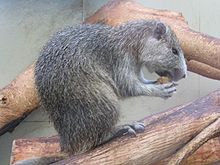Capromyidae
| Hutia Temporal range: Early Miocene–Recent |
|
|---|---|
 |
|
| Capromys pilorides | |
| Scientific classification | |
| Kingdom: | Animalia |
| Phylum: | Chordata |
| Class: | Mammalia |
| Order: | Rodentia |
| Parvorder: | Caviomorpha |
| Family: |
Capromyidae Smith, 1842 |
| Genera | |
|
Capromys |
|
Capromys
Geocapromys
†Hexolobodon
†Isolobodon
Mesocapromys
Mysateles
Plagiodontia
†Rhizoplagiodontia
Hutias are moderately large cavy-like rodents of the family Capromyidae that inhabit the Caribbean Islands. Most species have a head-and-body length that ranges from 21 to 46 cm (8.3 to 18.1 in) and weigh less than 2 kg (4.4 lb), but Desmarest's hutia has a head-and-body length of 31 to 60 cm (12 to 24 in) and weighs 2.8–8.5 kg (6.2–18.7 lb). Twenty species of hutia have been identified, and at least a third are extinct. (Their larger relatives the giant hutias, of the family Heptaxodontidae, are entirely extinct.) They resemble the nutria in some respects. Tails are present, varying from vestiges to prehensile. They have stout bodies and large heads. Most species are herbivorous, though some consume small animals. Instead of burrowing underground, they nest in trees or rock crevices. Only Desmarest's hutia and the prehensile-tailed hutia remain common and widespread; all other extant species are considered threatened by the IUCN.
They are hunted for food in Cuba, where they are often cooked in a large pot with wild nuts and honey. At the Guantanamo Bay Naval Base however, there is an over population due to an abundant food source and the lack of natural predators. Desmarest's hutias are referred to by those stationed at the Guantanamo Bay Naval Base as banana rats. Banana rats are not named for their dietary preference, but because their feces look like small versions of the fruit. They are known to come out at night.
...
Wikipedia
